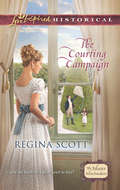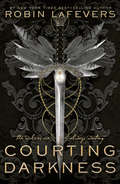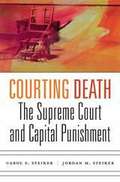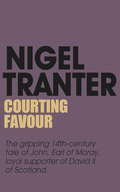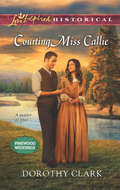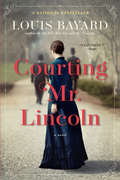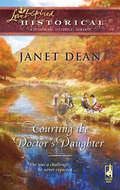- Table View
- List View
Courtier, Scholar, and Man of the Sword: Lord Herbert of Cherbury and his World
by Christine JacksonLord Herbert of Cherbury was a flamboyant Stuart courtier, soldier, and diplomat who acquired a reputation for duelling and extravagance but also numbered among the leading intellectuals of his generation. He travelled widely in Britain and Europe, enjoyed the patronage of princely rulers and their consorts, acquired celebrity as the embodiment of chivalric values, and defended European Protestantism on the battlefield and in diplomatic exchanges. As a scholar and author of De veritate and The Life and Raigne of King Henry the Eighth, he commanded respect in the European Republic of Letters and accumulated a much-admired library. As a courtier, he penned poetry and exchanged verses with John Donne and Ben Jonson, compiled a famous lute-book, wrote a widely-read autobiography, commissioned exquisite portraits by leading court artists, and built an impressive country house. Herbert was an enigmatic Janus figure who cherished the masculine values and martial lifestyle of his ancestors but embraced the Renaissance scholarship and civility of the early modern court and anticipated the intellectual and theological liberalism of the Enlightenment. His life and writings provide a unique window into the aristocratic world and cultural mindset of the early seventeenth century and the outbreak and impact of the Thirty Years War and British Civil Wars. This volume examines his career, life-style, political allegiances, religious beliefs, and scholarship within their British and European contexts, challenges the reputation he has acquired as a dilettante scholar, boastful auto-biographer, royalist turncoat and early deist, and offers a new assessment of his life and achievement.
Courtier, Scholar, and Man of the Sword: Lord Herbert of Cherbury and his World
by Christine JacksonLord Herbert of Cherbury was a flamboyant Stuart courtier, soldier, and diplomat who acquired a reputation for duelling and extravagance but also numbered among the leading intellectuals of his generation. He travelled widely in Britain and Europe, enjoyed the patronage of princely rulers and their consorts, acquired celebrity as the embodiment of chivalric values, and defended European Protestantism on the battlefield and in diplomatic exchanges. As a scholar and author of De veritate and The Life and Raigne of King Henry the Eighth, he commanded respect in the European Republic of Letters and accumulated a much-admired library. As a courtier, he penned poetry and exchanged verses with John Donne and Ben Jonson, compiled a famous lute-book, wrote a widely-read autobiography, commissioned exquisite portraits by leading court artists, and built an impressive country house. Herbert was an enigmatic Janus figure who cherished the masculine values and martial lifestyle of his ancestors but embraced the Renaissance scholarship and civility of the early modern court and anticipated the intellectual and theological liberalism of the Enlightenment. His life and writings provide a unique window into the aristocratic world and cultural mindset of the early seventeenth century and the outbreak and impact of the Thirty Years War and British Civil Wars. This volume examines his career, life-style, political allegiances, religious beliefs, and scholarship within their British and European contexts, challenges the reputation he has acquired as a dilettante scholar, boastful auto-biographer, royalist turncoat and early deist, and offers a new assessment of his life and achievement.
Courtiers: The inside story of the Palace power struggles from the Royal correspondent who revealed the bullying allegations
by Valentine LowThe gripping account of how the Royal family really operates from the man who has spent years studying them in his role as Royal correspondent for The Times. Valentine Low asks the important questions: who really runs the show and, as Charles III begins his reign, what will happen next? Throughout history, the British monarchy has relied on its courtiers - the trusted advisers in the King or Queen's inner circle - to ensure its survival as a family, an ancient institution, and a pillar of the constitution. Today, as ever, a vast team of people hidden from view steers the royal family's path between public duty and private life. Queen Elizabeth II, after a remarkable 70 years of service, saw the final seasons of her reign without her husband Philip to guide her. Meanwhile, newly ascended Charles seeks to define what his future as King, and that of his court, will be. The question of who is entrusted to guide the royals has never been more vital, and yet the task those courtiers face has never been more challenging. With a cloud hanging over Prince Andrew as well as Harry and Meghan's departure from royal life, the complex relationship between modern courtiers and royal principals has been exposed to global scrutiny. As the new Prince and Princess of Wales, William and Kate - equipped with a very 21st century approach to press and public relations - now hold the responsibility of making an ancient institution relevant for the decades to come. Courtiers reveals an ever-changing system of complex characters, shifting values and ideas over what the future of the institution should be. This is the story of how the monarchy really works, at a pivotal moment in its history.
Courtiers: The Secret History of the Georgian Court
by Lucy WorsleyIn the eighteenth century, the palace's most elegant assembly room was in fact a bloody battlefield. This was a world of skulduggery, politicking, wigs and beauty-spots, where fans whistled open like flick-knives.Ambitious and talented people flocked to court of George II and Queen Caroline in search of power and prestige, but Kensington Palace was also a gilded cage. Successful courtiers needed level heads and cold hearts; their secrets were never safe. Among them, a Vice Chamberlain with many vices, a Maid of Honour with a secret marriage, a pushy painter, an alcoholic equerry, a Wild Boy, a penniless poet, a dwarf comedian, two mysterious turbaned Turks and any number of discarded royal mistresses.An eye-opening portrait of a group of royal servants, Courtiers also throws new light on the dramatic life of George II and Queen Caroline at Kensington Palace.
The Courtiers: Splendor and Intrigue in the Georgian Court at Kensington Palace
by Lucy WorsleyKensington Palace is now most famous as the former home of Diana, Princess of Wales, but the palace's glory days came between 1714 and 1760, during the reigns of George I and II . In the eighteenth century, this palace was a world of skulduggery, intrigue, politicking, etiquette, wigs, and beauty spots, where fans whistled open like switchblades and unusual people were kept as curiosities. Lucy Worsley's The Courtiers charts the trajectory of the fantastically quarrelsome Hanovers and the last great gasp of British court life. Structured around the paintings of courtiers and servants that line the walls of the King's Staircase of Kensington Palace-paintings you can see at the palace today-The Courtiers goes behind closed doors to meet a pushy young painter, a maid of honor with a secret marriage, a vice chamberlain with many vices, a bedchamber woman with a violent husband, two aging royal mistresses, and many more. The result is an indelible portrait of court life leading up to the famous reign of George III , and a feast for both Anglophiles and lovers of history and royalty.
The Courtiers' Anatomists: Animals and Humans in Louis XIV's Paris
by Anita GuerriniThe Courtiers' Anatomists is about dead bodies and live animals in Louis XIV's Paris--and the surprising links between them. Examining the practice of seventeenth-century anatomy, Anita Guerrini reveals how anatomy and natural history were connected through animal dissection and vivisection. Driven by an insatiable curiosity, Parisian scientists, with the support of the king, dissected hundreds of animals from the royal menageries and the streets of Paris. Guerrini is the first to tell the story of Joseph-Guichard Duverney, who performed violent, riot-inducing dissections of both animal and human bodies before the king at Versailles and in front of hundreds of spectators at the King's Garden in Paris. At the Paris Academy of Sciences, meanwhile, Claude Perrault, with the help of Duverney’s dissections, edited two folios in the 1670s filled with lavish illustrations by court artists of exotic royal animals. Through the stories of Duverney and Perrault, as well as those of Marin Cureau de la Chambre, Jean Pecquet, and Louis Gayant, The Courtiers' Anatomists explores the relationships between empiricism and theory, human and animal, as well as the origins of the natural history museum and the relationship between science and other cultural activities, including art, music, and literature.
The Courtiers' Anatomists: Animals and Humans in Louis XIV's Paris
by Anita GuerriniThe Courtiers' Anatomists is about dead bodies and live animals in Louis XIV's Paris--and the surprising links between them. Examining the practice of seventeenth-century anatomy, Anita Guerrini reveals how anatomy and natural history were connected through animal dissection and vivisection. Driven by an insatiable curiosity, Parisian scientists, with the support of the king, dissected hundreds of animals from the royal menageries and the streets of Paris. Guerrini is the first to tell the story of Joseph-Guichard Duverney, who performed violent, riot-inducing dissections of both animal and human bodies before the king at Versailles and in front of hundreds of spectators at the King's Garden in Paris. At the Paris Academy of Sciences, meanwhile, Claude Perrault, with the help of Duverney’s dissections, edited two folios in the 1670s filled with lavish illustrations by court artists of exotic royal animals. Through the stories of Duverney and Perrault, as well as those of Marin Cureau de la Chambre, Jean Pecquet, and Louis Gayant, The Courtiers' Anatomists explores the relationships between empiricism and theory, human and animal, as well as the origins of the natural history museum and the relationship between science and other cultural activities, including art, music, and literature.
The Courtiers' Anatomists: Animals and Humans in Louis XIV's Paris
by Anita GuerriniThe Courtiers' Anatomists is about dead bodies and live animals in Louis XIV's Paris--and the surprising links between them. Examining the practice of seventeenth-century anatomy, Anita Guerrini reveals how anatomy and natural history were connected through animal dissection and vivisection. Driven by an insatiable curiosity, Parisian scientists, with the support of the king, dissected hundreds of animals from the royal menageries and the streets of Paris. Guerrini is the first to tell the story of Joseph-Guichard Duverney, who performed violent, riot-inducing dissections of both animal and human bodies before the king at Versailles and in front of hundreds of spectators at the King's Garden in Paris. At the Paris Academy of Sciences, meanwhile, Claude Perrault, with the help of Duverney’s dissections, edited two folios in the 1670s filled with lavish illustrations by court artists of exotic royal animals. Through the stories of Duverney and Perrault, as well as those of Marin Cureau de la Chambre, Jean Pecquet, and Louis Gayant, The Courtiers' Anatomists explores the relationships between empiricism and theory, human and animal, as well as the origins of the natural history museum and the relationship between science and other cultural activities, including art, music, and literature.
The Courtiers' Anatomists: Animals and Humans in Louis XIV's Paris
by Anita GuerriniThe Courtiers' Anatomists is about dead bodies and live animals in Louis XIV's Paris--and the surprising links between them. Examining the practice of seventeenth-century anatomy, Anita Guerrini reveals how anatomy and natural history were connected through animal dissection and vivisection. Driven by an insatiable curiosity, Parisian scientists, with the support of the king, dissected hundreds of animals from the royal menageries and the streets of Paris. Guerrini is the first to tell the story of Joseph-Guichard Duverney, who performed violent, riot-inducing dissections of both animal and human bodies before the king at Versailles and in front of hundreds of spectators at the King's Garden in Paris. At the Paris Academy of Sciences, meanwhile, Claude Perrault, with the help of Duverney’s dissections, edited two folios in the 1670s filled with lavish illustrations by court artists of exotic royal animals. Through the stories of Duverney and Perrault, as well as those of Marin Cureau de la Chambre, Jean Pecquet, and Louis Gayant, The Courtiers' Anatomists explores the relationships between empiricism and theory, human and animal, as well as the origins of the natural history museum and the relationship between science and other cultural activities, including art, music, and literature.
The Courting Campaign: The Courting Campaign The Wife Campaign The Husband Campaign (The Master Matchmakers #1)
by Regina ScottEmma Pyrmont has no designs on handsome Sir Nicholas Rotherford—at least not for herself. As his daughter's nanny, she sees how lonely little Alice has been.
Courting Danger With Mr Dyer: An Innocent Maid For The Duke Courting Danger With Mr. Dyer Scandal And Miss Markham (Scandal and Disgrace)
by Georgie LeeA stolen kiss from a spy!
Courting Darkness (His Fair Assassin)
by Robin LaFeversWhen Sybella accompanies the Duchess of Brittany to France, she expects trouble, but she isn’t expecting a deadly trap. Surrounded by enemies both known and unknown, Sybella searches for the undercover assassins from the convent of St. Mortain who were placed in the French court years ago. Genevieve has been undercover for so many years, she no longer knows who she is or what she’s supposed to be fighting for. When she discovers a hidden prisoner who may be of importance, she takes matters into her own hands. As these two worlds collide, the fate of the Duchess, Brittany, and everything Sybella and Genevieve have come to love hangs in the balance.
Courting Death: The Supreme Court And Capital Punishment
by Carol S. SteikerRefusing to eradicate the death penalty, the U.S. has attempted to reform and rationalize capital punishment through federal constitutional law. While execution chambers remain active in several states, Carol Steiker and Jordan Steiker argue that the fate of the American death penalty is likely to be sealed by this failed judicial experiment.
Courting Death: The Supreme Court And Capital Punishment
by Carol S. SteikerRefusing to eradicate the death penalty, the U.S. has attempted to reform and rationalize capital punishment through federal constitutional law. While execution chambers remain active in several states, Carol Steiker and Jordan Steiker argue that the fate of the American death penalty is likely to be sealed by this failed judicial experiment.
Courting Disaster: Astrology At The English Court And University In The Later Middle (pdf)
by Hilary M Carey Florin CurtaCourting Favour
by Nigel TranterWhen his mother, the formidable Black Agnes, bequeathed him the troubledearldom of Moray in the far north of Scotland, John Cospatrick, youngerson of the ninth Earl of Dunbar and March, found himself unexpectedlyelevated to become King David's lieutenant and arbiter up in thoseunruly parts. At the age of 22, with no experience in matters ofgovernance, John's courage, sharp wit and skills of diplomacy served himwell in bringing the rebellious Lords of the Isles to heel.However, the greatest test of his abilities as an envoy and negotiatorwas to come when the new king, Robert II, sent him to London to seek towin over the English king's brother, John of Gaunt, to friendship withScotland.The fascinating 14th century tale of John, Earl of Moray, loyalsupporter of David II of Scotland, as told by Nigel Tranter, master ofScottish historical fiction.
Courting The Forbidden Debutante: A Duke In Need Of A Wife His Three-day Duchess Courting The Forbidden Debutante (Scandalous Australian Bachelors #1)
by Laura MartinCourt a beautiful debutante… Or fulfil his quest for vengeance?
Courting India: England, Mughal India and the Origins of Empire
by Nandini DasA profound and ground-breaking new history of one of the most important encounters in the history of colonialism: the British arrival in India in the early seventeenth century.'A fascinating glimpse of the origins of the British Empire . . . drawn in dazzling technicolour' Spectator'Beautifully written and masterfully researched, this has the makings of a classic' Peter Frankopan*A Financial Times Book to Read in 2023*When Thomas Roe arrived in India in 1616 as James I's first ambassador to the Mughal Empire, the English barely had a toehold in the subcontinent. Their understanding of South Asian trade and India was sketchy at best, and, to the Mughals, they were minor players on a very large stage. Roe was representing a kingdom that was beset by financial woes and deeply conflicted about its identity as a unified 'Great Britain' under the Stuart monarchy. Meanwhile, the court he entered in India was wealthy and cultured, its dominion widely considered to be one of the greatest and richest empires of the world.In Nandini Das's fascinating history of Roe's four years in India, she offers an insider's view of a Britain in the making, a country whose imperial seeds were just being sown. It is a story of palace intrigue and scandal, lotteries and wagers that unfolds as global trade begins to stretch from Russia to Virginia, from West Africa to the Spice Islands of Indonesia.A major debut that explores the art, literature, sights and sounds of Jacobean London and Imperial India, Courting India reveals Thomas Roe's time in the Mughal Empire to be a turning point in history – and offers a rich and radical challenge to our understanding of Britain and its early empire.
Courting India: England, Mughal India and the Origins of Empire
by Nandini DasA profound and ground-breaking new history of one of the most important encounters in the history of colonialism: the British arrival in India in the early seventeenth century.'A fascinating glimpse of the origins of the British Empire . . . drawn in dazzling technicolour' Spectator'Beautifully written and masterfully researched, this has the makings of a classic' Peter Frankopan*A Financial Times Book to Read in 2023*When Thomas Roe arrived in India in 1616 as James I's first ambassador to the Mughal Empire, the English barely had a toehold in the subcontinent. Their understanding of South Asian trade and India was sketchy at best, and, to the Mughals, they were minor players on a very large stage. Roe was representing a kingdom that was beset by financial woes and deeply conflicted about its identity as a unified 'Great Britain' under the Stuart monarchy. Meanwhile, the court he entered in India was wealthy and cultured, its dominion widely considered to be one of the greatest and richest empires of the world.In Nandini Das's fascinating history of Roe's four years in India, she offers an insider's view of a Britain in the making, a country whose imperial seeds were just being sown. It is a story of palace intrigue and scandal, lotteries and wagers that unfolds as global trade begins to stretch from Russia to Virginia, from West Africa to the Spice Islands of Indonesia.A major debut that explores the art, literature, sights and sounds of Jacobean London and Imperial India, Courting India reveals Thomas Roe's time in the Mughal Empire to be a turning point in history – and offers a rich and radical challenge to our understanding of Britain and its early empire.
Courting Miss Adelaide: Wilderness Courtship Courting Miss Adelaide (Mills And Boon Historical Ser.)
by Janet DeanIndulge your fantasies of delicious Regency Rakes, fierce Viking warriors and rugged Highlanders. Be swept away into a world of intense passion, lavish settings and romance that burns brightly through the centuries The "orphan train" seemed like small-town spinster Adelaide Crum's last chance to know the simple joys of family life.
Courting Miss Callie (Pinewood Weddings #2)
by Dorothy ClarkSEEKING TRUE LOVE Stunningly beautiful Callie Conner is sick of being pursued by shallow suitors. She wants a man of faith, honesty, and moral integrity who will love and value her for more than her appearance. So she flees to her aunt’s hotel, where she soon finds herself falling for the handsome new stable hand.
Courting Miss Vallois: Brushed By Scandal / Courting Miss Vallois (Mills And Boon Historical Ser.)
by Gail WhitikerFROM THE FIELDS OF FRANCE… Miss Sophie Vallois’ looks and grace make her an instant hit with London Society. No one would know that the French beauty is a mere farmer’s daughter, with no interest in marriage whatsoever…
Courting Mr. Lincoln: A Novel
by Louis BayardIncludes a special preview chapter of Jackie & Me, coming June 14 from Louis Bayard &“Riveting . . . Enticing.&” —The Washington Post &“Exquisite.&” —People &“A triumph of a novel.&” —Bookreporter.com &“Rich, fascinating, and romantic.&” —NewsdayA Washington Post Bestseller * An Indie Next Pick * An Apple Books Best of the Month for April * A People Magazine Best Book of the Week When Mary Todd meets Abraham Lincoln in Springfield in the winter of 1840, he is on no one&’s short list to be president. Mary, a quick, self-possessed debutante with an interest in debates and elections, at first finds this awkward country lawyer an enigma. &“I can only hope,&” she tells his roommate, the handsome, charming Joshua Speed, &“that his waters being so very still, they also run deep.&” It&’s not long, though, before she sees the Lincoln that Speed knows: an amiable, profound man with a gentle wit to match his genius, who respects her keen political mind. But as her relationship with Lincoln deepens, she must confront his inseparable friendship with Speed, who has taught his roommate how to dance, dress, and navigate polite society. Told in the alternating voices of Mary Todd and Joshua Speed, and inspired by historical events, Courting Mr. Lincoln creates a sympathetic and complex portrait of Mary unlike any that has come before; a moving portrayal of the deep and very real connection between the two men; and most of all, an evocation of the unformed man who would grow into one of the nation&’s most beloved presidents.
Courting Sanctity: Holy Women and the Capetians
by Sean L. FieldThe rise of the Capetian dynasty across the long thirteenth century, which rested in part on the family's perceived sanctity, is a story most often told through the actions of male figures, from Louis IX's metamorphosis into "Saint Louis" to Philip IV's attacks on Pope Boniface VIII. In Courting Sanctity, Sean L. Field argues that, in fact, holy women were central to the Capetian's self-presentation as being uniquely favored by God. Tracing the shifting relationship between holy women and the French royal court, he shows that the roles and influence of these women were questioned and reshaped under Philip III and increasingly assumed to pose physical, spiritual, and political threats by the time of Philip IV's death. Field's narrative highlights six holy women. The saintly reputations of Isabelle of France and Douceline of Digne helped to crystalize the Capetians' claims of divine favor by 1260. In the 1270s, the French court faced a crisis that centered on the testimony of Elizabeth of Spalbeek, a visionary holy woman from the Low Countries. After 1300, the arrests and interrogations of Paupertas of Metz, Margueronne of Bellevillette, and Marguerite Porete served to bolster Philip IV's crusades against the dangers supposedly threatening the kingdom of France. Courting Sanctity thus reassesses key turning points in the ascent of the "most Christian" Capetian court through examinations of the lives and images of the holy women that the court sanctified or defamed.
Courting the Doctor's Daughter: Courting The Doctor's Daughter Spring Creek Bride (Mills And Boon Historical Ser.)
by Janet DeanIndulge your fantasies of delicious Regency Rakes, fierce Viking warriors and rugged Highlanders. Be swept away into a world of intense passion, lavish settings and romance that burns brightly through the centuries A widow with three boys to raise, Mary Graves has no time for peddlers of phony medicine.





